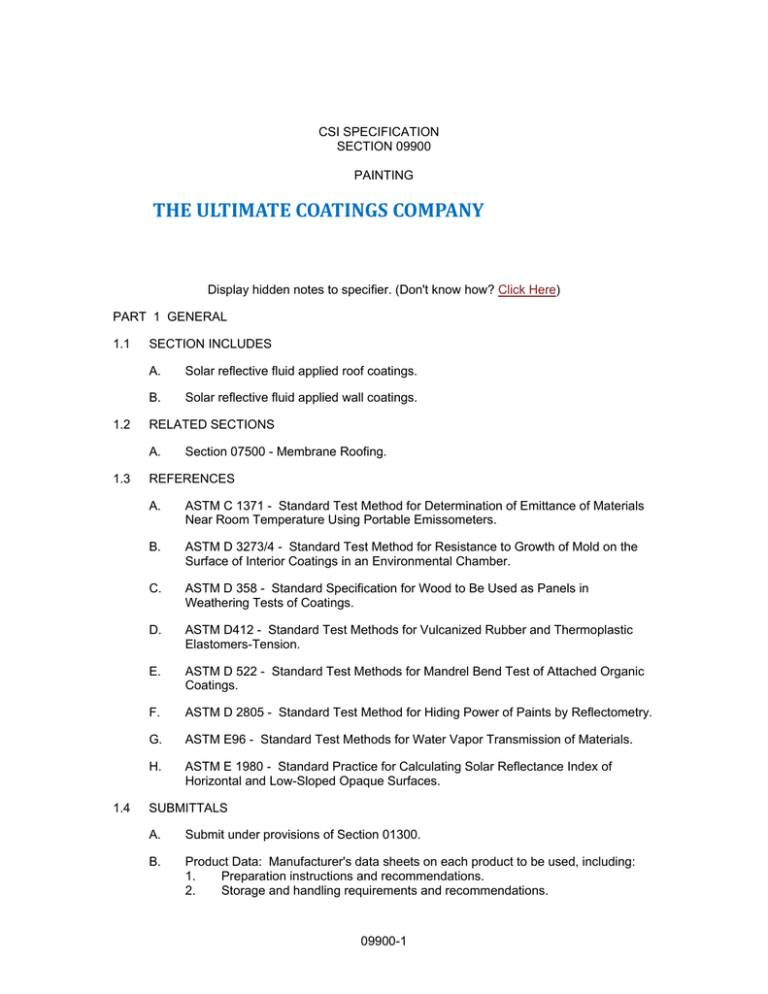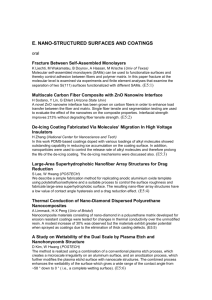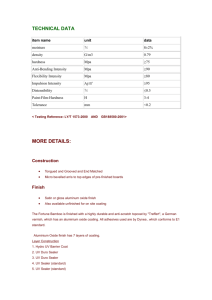THE ULTIMATE COATINGS COMPANY
advertisement

CSI SPECIFICATION SECTION 09900 PAINTING THEULTIMATECOATINGSCOMPANY Display hidden notes to specifier. (Don't know how? Click Here) PART 1 GENERAL 1.1 1.2 SECTION INCLUDES A. Solar reflective fluid applied roof coatings. B. Solar reflective fluid applied wall coatings. RELATED SECTIONS A. 1.3 1.4 Section 07500 - Membrane Roofing. REFERENCES A. ASTM C 1371 - Standard Test Method for Determination of Emittance of Materials Near Room Temperature Using Portable Emissometers. B. ASTM D 3273/4 - Standard Test Method for Resistance to Growth of Mold on the Surface of Interior Coatings in an Environmental Chamber. C. ASTM D 358 - Standard Specification for Wood to Be Used as Panels in Weathering Tests of Coatings. D. ASTM D412 - Standard Test Methods for Vulcanized Rubber and Thermoplastic Elastomers-Tension. E. ASTM D 522 - Standard Test Methods for Mandrel Bend Test of Attached Organic Coatings. F. ASTM D 2805 - Standard Test Method for Hiding Power of Paints by Reflectometry. G. ASTM E96 - Standard Test Methods for Water Vapor Transmission of Materials. H. ASTM E 1980 - Standard Practice for Calculating Solar Reflectance Index of Horizontal and Low-Sloped Opaque Surfaces. SUBMITTALS A. Submit under provisions of Section 01300. B. Product Data: Manufacturer's data sheets on each product to be used, including: 1. Preparation instructions and recommendations. 2. Storage and handling requirements and recommendations. 09900-1 3. C. 1.5 1.6 1.7 Installation methods. Warranty Submittal: Two or more photographs shall be taken at each stage of the coating (initial, power-washing, clear sealing, seal coating including edges, and after the final glaze coat.). Provide photographic documentation in accordance with manufacturer's warranty provisions. QUALITY ASSURANCE A. Manufacturer Qualifications: Manufacturer shall formulate and mix final product for distribution. Private labeling from other sources is prohibited. B. Installer Qualifications: Installers shall be approved in writing by the manufacturer. C. Product Requirements: 1. Product shall be certified 100 percent free of ethylene glycol. 2. Product shall be formulated with no plasticizers. 3. Product shall be California Title 24 compliant. D. Mock-Up: Provide a mock-up for evaluation of surface preparation techniques and application workmanship. 1. Finish areas designated by Architect. 2. Do not proceed with remaining work until workmanship, color, and sheen are approved by Architect. 3. Refinish mock-up area as required to produce acceptable work. DELIVERY, STORAGE, AND HANDLING A. Store products in manufacturer's unopened packaging until ready for installation. B. Store and dispose of solvent-based materials, and materials used with solventbased materials, in accordance with requirements of local authorities having jurisdiction. C. Use within product shelf life, approximately 12 months at 70 degrees Fahrenheit. PROJECT CONDITIONS A. Maintain environmental conditions (temperature, humidity, and ventilation) within limits recommended by manufacturer for optimum results. Do not install products under environmental conditions outside manufacturer's absolute limits. 1. Do not apply coatings during temperatures above 90 degrees F (32 degrees C) ambient temperature. 2. Do not apply paint onto tile surfaces over 110 degrees F (43 degrees C) or below 50 degrees F (10 degrees C). 3. Do not apply coatings when temperatures of 50 degrees or less are expected by evening or within 4 hours of expected temperature drop below 50 degrees F (10 degrees C). 4. Do not apply coatings in overhead direct sun or where overhead direct sun is expected within 1 hour. 5. Do not apply coatings when rain or fog conditions are expected within 4 hours. 6. Do not apply over sealers, primer, caulk or other repair materials that are not fully dried or cured. 7. Do not apply if surface is wet or has salt residue from salt-water fog. 8. Do not apply if heavy saltwater fog conditions or drizzle have occurred without rinsing seal coat painted surfaces between coats. 09900-2 1.8 WARRANTY A. Manufacturer/Contractor warrants material and installation for non-prorated 10 year warranties. B. Manufacturer/Contractor warrants material and installation for non-prorated 12 year warranties. C. A minimum of two coats over properly prepared substrate shall be provided to comply with warranty provisions. Product shall not be applied in one heavy coat. PART 2 PRODUCTS 2.1 2.2 MANUFACTURERS A. Acceptable Manufacturer: The Ultimate Coatings Company, which is located at: 3020 Bridgeway Suite 150 ; Sausalito, CA 94965; Tel: 415-726-0551; Fax: 415-4531943; Email: request info; Web: www.ultimatecoatings.net B. Substitutions: Not permitted. C. Requests for substitutions will be considered in accordance with provisions of Section 01600. THERMOPLASTIC ACRYLIC COATING PROPERTIES A. Thermoplastic Acrylic Product Characteristics: 1. Solids by Volume: 41 percent plus or minus 2 percent. 2. Solids by Weight: 53 percent plus or minus 2 percent. 3. Weight per Gallon: 11.1 lb (5 kg). 4. VOC: Less than 50 grams/liter (0.417 lb/ gal). 5. Tints (pigments) Intrinsic, Ferro MMO infra-red. 6. Primary Material: Rohm & Haas acrylic thermoplastic. B. Thermoplastic Acrylic Product Properties: 1. Thermal Emittance (ASTM C 1371): 87-93 percent. 2. Solar Reflectance (ASTM E 1549): 40-91 percent. 3. Solar Reflective Index (ASTM E 1980): 80-115. 4. Water Vapor Transmission (ASTM E96): 15 perms. 5. Water Resistance (ASTM D 358): Pass. 6. Wind-Driven Rain (TTC-555B): Pass. 7. Flexibility (ASTM D 522): Pass. 8. Alkali Resistance (ASTM D 3273): Pass. 9. Mildew Resistance: HIGH - Biocide Chemistry. 10. Dirt Resistance: SUPERIOR - Semi-gloss 50, 60 gloss finish. 11. Hiding Power (ASTM D 2805): 97.3 percent. 12. Tensile Strength (ASTM D412): 500 psi (350,000 kgs/sq.m.). 13. Hardness (Shore A): 92-98. 14. Note: Solar Reflective Values are color dependant. C. Thermoplastic Acrylic Product Performance: 1. Solar Reflective: Reflects over 40 percent in terracotta tints; 80 percent in beige tints, over 90 percent in whites 2. Thermal Emissive: Emissive at over 80 percent in darker colors; over 90 percent in white. 3. Cross-Linking Adhesion: Bonds powerfully through the base paint into underlying material. 09900-3 4. 5. 6. 7. 8. 9. 10. 11. 12. 13. 2.3 THERMOPLASTIC ACRYLIC MAINTENANCE COATING FOR CONCRETE, CEMENTITIOUS AND CLAY ROOF TILES A. 2.4 Dirt Shedding: Substantially harder coating surface that resists dirt pick-up; dirt washes off. Strength: High tensile capability gives exceptional resistance to foot traffic and hail storms. Intrinsic Colors and Infra-Red Pigments: Low VOCs, environmentally friendly, and color stable. Mildew Resistant: Biocide component reduces plant-life and molds from rooting. Breathable: "Permeance" rating of 15.0 allows water vapor escape to the outside. Title 24 Compliant: Exceeds California's strict compliance regulations. Lowest Odor: Low VOCs (0.50 g/L.) meets air quality standards in all districts. Water Clean-Up: Low-toxic chemistry. Tile Roof Restoration: Maintenance for failing cementitious tiles. Fully renewable coating. Durability: 10-15 years. High solids by volume. System: 1. Prime coat shall be applied over properly prepared tiles. Minimum coverage of 300 to 400 sq ft per gallon (7.5 sq. m/l to 10 sq. m/l) required. Thermo-Seal 1000 Finish Paint coverage over primed tiles shall be a minimum of two (2) coats of 185 to 225 square feet per gallon (5 sq. m/l to 6.25 sq. m/l). Final finish sealer - Glaze Coat 500 over Finish Paint shall be applied at a minimum of 300 - 400 sq ft per gallon (7.5 sq. m/l to 10 sq. m/l) 2. Primer: Clear Masonry Sealer 990 as manufactured by The Ultimate Coatings Company. 3. Finish: Thermo-Seal 1000 as manufactured by The Ultimate Coatings Company. 4. Sealer: GlazeCoat 500 as manufactured by The Ultimate Coatings Company. 5. Color: Match architect's sample. THERMOPLASTIC ARCYLIC COATING OVER VERTICAL AND HORIZONTAL STUCCO AND CONCRETE WALLS, SIDING A. System: 1. Prime coat shall be applied to repaired and new surfaces. Sealer coverage over properly prepared surfaces shall be a minimum of 250 to 300 square feet per gallon (5 sq. m/l to 5.6 sq. m/l). 2. Epoxy Primer: 100 percent solids-based primer for concrete substrate in need of consolidation as approved by The Ultimate Coatings Company. 3. Wood Siding Primer: Bonding Primer 390 as manufactured by The Ultimate Coatings Company. 4. Finish Paint: Thermo-Seal 1500 as manufactured by The Ultimate Coatings Company. 5. Color: Match architect's sample. PART 3 EXECUTION 3.1 EXAMINATION A. Do not begin coating installation until substrates have been properly prepared. 1. Do not apply over failed finishes. 2. Do not apply finish directly over chalked painted surfaces. Chalky paint shall be scrubbed and power-washed prior to sealing. 09900-4 3. 4. 5. 3.2 3.3 Do not use alkyd primer over concrete substrates to avoid Saponification (soaping) caused failures. Do not apply over deteriorated T-111, plywood or veneers. T-111 substrates require, a manufacturer's representative to approve the substrates prior to application. Do not apply coating systems over cedar wood shake, Cal-Shake brand or any Cemwood type wood/cement, or synthetic roof shingles. B. Products used as a primer, basecoat, or glaze coat shall be provided by or approved in advance and in writing by coating systems manufacturer. C. If substrate preparation is the responsibility of another installer, notify Architect of unsatisfactory preparation before proceeding. WALL PREPARATION A. Prepare surfaces using the methods recommended by the manufacturer for achieving the best result for the substrate under the project conditions. B. Remove mildew and power washing (with 2 days minimum dry time). If cracks, holes or spalling are present, these shall be filled and matched to existing texture of walls prior to spot priming. Spot priming shall be done over repairs. C. Failed Prior Coatings: 1. Failed prior coatings shall be completely removed. Ultra-high pressure power washing with containment and/or water-based chemical stripper shall be used. Old surface coatings that remain shall be removed in full. D. Deteriorated Stucco or Concrete Substrates: 1. Where repairs to surfaces are needed, clean and wash stucco or concrete surfaces prior to repairs. Patch all holes and significant blemishes. Walls and horizontals may then be primed in full with acrylic bonding primer or sealed in full with epoxy primer system. WALL COATING INSTALLATION A. Install in accordance with manufacturer's instructions. B. Finish Coating Application: 1. Sprayer: Apply thermoplastic coating with airless sprayer with a steady horizontal pattern with 3 inches (76 mm) overlaps. Care shall be taken to ensure that the coating is not piled up on the wall surfaces and that excessive material is not permitted to sag down. 2. Hand-Rolled: Apply coats with 3/4 inch nap, 100 percent wool or wool blend, roller cover. Finish with down strokes, each pass, to ensure coating flows to uniform surface when dry. C. Back-Rolling: Provide back rolling per manufacturer instructions to achieve consistent final finish appearance. D. Number of Coats: A minimum of 2 coats shall be applied over existing painted surfaces. E. Minimum Film Thickness: A minimum film thickness of 6 to 8 wet mils (0.1524 mm to 0.2032 mm) per coat shall be achieved. F. Metal Substrates: Do not over-apply coatings onto metal substrates to avoid sag and over build. Work shall be double-checked after a few minutes. 09900-5 3.4 3.5 3.6 G. Factory Primed Siding: Re-prime using Bonding Primer. H. Primed surfaces shall be re-coated with primer if final finish coating not applied within 30 days of initial application. ROOF TILES PREPARATION A. Prepare surfaces using the methods recommended by the manufacturer for achieving the best result for the substrate under the project conditions. B. Remove mold, mildew and fungal materials from surfaces to be coated with biocide cleaner per biocide manufacturer's instructions. Power wash surface to neutralize and rinse surface of debris. C. Damaged and loose tiles shall be replaced and repair of sub roof, flashings and/or valleys prior to the sealing of tiles. D. Failed Prior Coatings: 1. Failed prior coatings shall be completely removed. Ultra-high pressure power washing with containment and/or water-based, low-toxic chemical stripper shall be used. Failed older thick surface coatings that remain shall be removed in full. E. Cracks and moving joints shall be caulked and/or grouted prior to the sealing of tiles. ROOF COATING INSTALLATION A. Install in accordance with manufacturer's instructions. B. Primer: 1. Airless Sprayer: Apply primer in a steady parallel pattern with 3 inches (76 mm) overlaps running from the lowest perimeter edge of the whole tile roof on upwards to the roof peak then recommencing again from the lowest perimeter edge. Care should be taken to ensure full coverage of the lowest edge of each tile and into open seams between tiles. Do not thin primer. C. Sealer: 1. Apply seal coat by airless sprayer in a steady, parallel pattern at slower speed with 3 inches (76 mm) overlaps running from the lowest perimeter edge of the whole tile roof on upwards to the roof peak then recommencing again from the lowest perimeter edge. Care should be taken to ensure full coverage of the lowest edge of each tile. 2. Two coats shall be applied with full drying between coats. 3. Sagging of sealer material shall be eliminated with back-rolling and backbrushing per manufacturer's instructions. 4. Minimum Film Thickness: A minimum film thickness of 6 to 8 wet mils (0.1524 mm to 0.2032 mm) per coat shall be achieved. D. Factory Sealed Tiles: Factory sealed or factory painted tiles shall be primed in full with Bonding Primer 390 prior to application of sealer coating. E. Primed surfaces shall be re-coated with Bonding Primer 390 if final finish coating not applied within 30 days of initial application. PROTECTION A. Protect installed products until completion of project. 09900-6 B. Touch-up, repair or replace damaged products before Substantial Completion. END OF SECTION 09900-7



